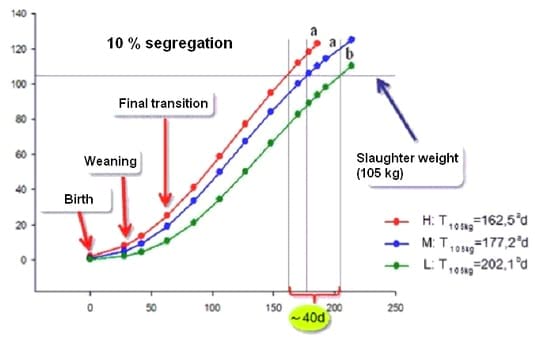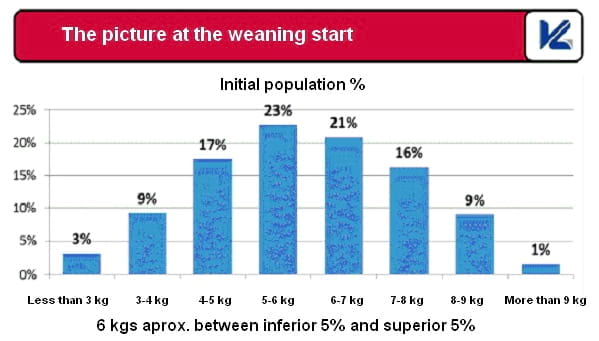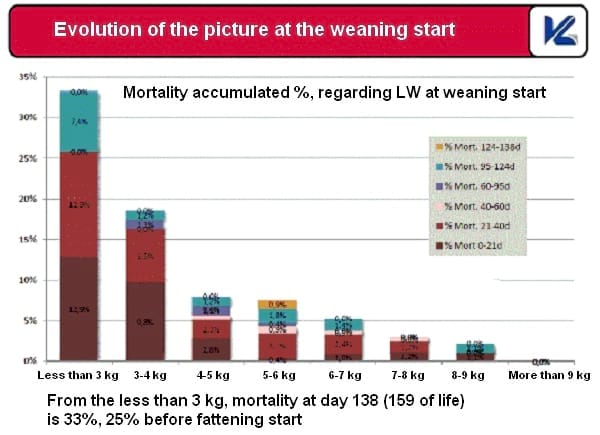



How to Reduce Pig Weight Variability?
In a sector aiming at standardizing the final product at the maximum, variability in pig weight at slaughter age is still one of the major issues in the swine industry nowadays, reports Miquel Collel (Director, Scientific Marketing Affairs, Global Swine) and Olivia Azlor (Global Marketing Director, Global Swine), Merck Animal Health.Why is pig weight variability important? – The world as a distribution and not an average
Producers often talk in terms of weight average, treating a batch as if it was a single animal. Consequently, the batch will be ready for selling when, in average, it reaches the optimal weight for slaughter. However, when these pigs will be evaluated, they will be considered individually: some will fall under the desired weight range, some will fall over (both carrying economic penalties), and only a few will fall inside the optimal weight range, reaching its full economical potential.
It is when we look at every group of pigs as a distribution instead of as an average that we quickly understand that, with the same average weight, the key is in reducing variance to get more animals falling within the desired range (D. DiPietri 2014).


Also, big differences in pig weight at slaughter age affect the optimal management of a farm, preventing the implementation of efficient all-in all-out programs.
When does variability start? - Variability in pig weight can start at birth. It has been widely documented that slight variations of piglet weight at birth amplify through the pig life causing (partially) the important differences that we can then find at slaughter age (Sergi López- Vergé & David Solà-Oriol, 3tres3 2015)

This “amplification effect” has been differently quantified in literature: a difference of 0.73 g between the 10% and the 90% percentile at birth may become a difference of 4,73 kg at fattening (source? Graph below) or 1,1 kg of difference at weaning may become 3,8 kg of difference at 138 days of age (A. Vela ESPHM 2015).
Regardless of the numerical difference per se, what is clear is that trying to homogenize piglets’ birth weight could be a key factor to achieve more homogeneous pigs at slaughter.

However, and despite the theory being well known, the reality can’t be more different.
The reality in piglet weight at birth

Albert Vidal, Jornadas UAB 2014
If a batch of pigs at slaughter age are better described as a distribution than an average, same applies to just born piglets. Piglets born within the same farrowing period (assuming batch management) can fall within a large range of weights. In recent data presented in the UAB talks, it was shown that the difference between the 5% lightest and the 5% heaviest piglets can be of more Other impacts of piglet birth weight
Piglet birth weight impacts not only the final pig weight, as we have just seen, but it also has a strong influence on piglet survival rate, or better said, on pre and post-weaning piglet mortality.

Very recently A. Vidal demonstrated that the cumulated percentage of mortality (from day 0 to day 138) for the group of pigs coming from the lightest piglets in a specific batch (weighting less than 3 kg) could raise up to 33% whereas the mortality for the pigs coming from the heaviest groups ( more than 9 kg) was of about 0%.
Therefore there are two reasons why we should be aiming at reducing piglet birth weight variability:
- to have more homogeneous pigs at slaughter
- to have less small piglets thus reducing piglet mortality
How old is a piglet at birth? - What causes piglet variability at birth?
We use to think that age at birth is 0 days, but this isn’t exactly true. At birth a piglet can be from 112 to 119 days old (ie. the gestation length).
We can say that variability in piglet weight starts before birth and comes from two sources. Indeed we have:
- Variability in piglets born from the same sow.
- Variability between piglets from different sows (different ages at birth).
Despite the first type of variability being badly understood and thus difficult to impact, we know some of the factors that explain the second type.
Variability within piglets from different sows can be explained, among others, by three main factors:
o Different conception date:
- Sows come to heat at different days during the week.
- Additionally, they are usually inseminated 2 to 3 times at different moments.
- It is logic to think that not all the sows will get pregnant at the same time.
o Different birth day: for a single batch, if not synchronized, the farrows may extend during a whole week, giving birth to piglets of different ages.
o Semen from different males.
We end up having every day of the week as possible conception day.
Other impacts of piglet age difference at birth
Piglets born from the same batch of sows will usually be raised together. This means that they will be weaned at the same time, fed equally, vaccinated at the same moment and treated with the same dose of antibiotic (calculated from the average age of the batch and thus theoretical average weight).
However, as we have seen, they may have quite different ages, which means that they might still have different feed needs and might still be at different stages of the development of their immunological system.
Some of the consequences of this can include digestive problems, failures in vaccination or antibiotic over or under-dosing.
How can we homogenize piglet birth weight?
If we concentrate into reducing variability within piglets from a single batch and from different sows, we have two leverages to play with:
- Synchronization of ovulation, of insemination and of parturition to obtain piglets with the same age.
- A single insemination that would allow us using fewer males, thus selecting the best ones, and reducing genetic variability.
Fortunately nowadays we can find in the market solutions to work towards these goals, as would be:
- GnRH analogues (such as buserelin) to synchronize ovulation and consequently needing only one insemination at a fixed time to achieve the same good results.
- Prostaglandins (such as cloprostenol) to synchronize parturition.
If the fight against pig weight variability is far from being over, we have started understanding some of the factors we can influence to control and reduce it as much as possible.








